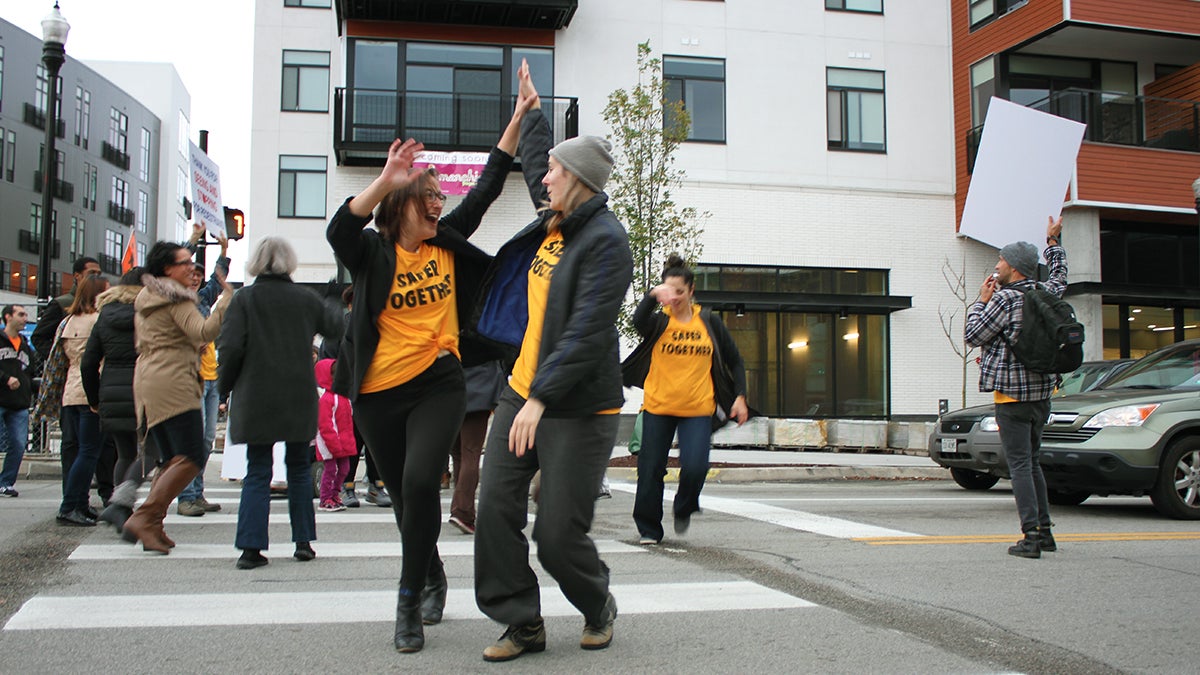Pittsburgh dances its way to Complete Streets legislation

Laura Hahn
In the name of safer streets, one group interpreted the “walk” signal a little differently.
On Monday Pittsburgh City Council unanimously recommended Complete Streets legislation for final approval. The policy is essentially a city-wide blueprint to make streets safer, more accessible, and convenient for everyone.
More than 950 such policies have been adopted in the United States and Puerto Rico, according to Smart Growth America, a nonprofit that advocates for strengthening the nation’s neighborhoods. And the idea of Pittsburgh’s Complete Streets policy is to change how people think about streets.
Councilman Dan Gilman said as the city’s millennial population grows, and as many residents grow older, the infrastructure must change to accommodate their needs.
“Our streets need to be built and transformed to support walkers, cyclists, public transit users, and not just built around the car.”
Usually, when people want to show support for a policy they sign up to make a public comment at a City Council meeting. But to bring awareness to the need for safer shared streets, one group decided to do things a little differently.
At a busy intersection outside Target last week, about 20 people waited anxiously for the walk signal. When the light changed, they danced into the crosswalk. As James Brown’s “Get on the Good Foot” played, they spun, they shimmied, they high-fived.
“Crossings” was a performance piece organized by Lively Pittsburgh, a group dedicated to building healthy, active communities. The afternoon event was meant to remind motorists that streets are for everyone, said Jason Jablon, event coordinator for Lively Pittsburgh. Jablon said walkers, bikers, drivers, those using public transit, everyone is “safer together.” He pointed to the motto, emblazoned on his yellow t-shirt.
“We’re trying to bring that awareness to everybody that we can all cross, and be safe, and please pay attention to us as we do it.”
Amy Mackewich and her daughter joined the crosswalk dance as they passed the group in late afternoon. Mackewich uses a motorized chair and said she has a lot of trouble crossing the street.
“The cars are so impatient with people. They constantly honk and don’t want to wait for me.”
It’s easy to forget that streets are more than just the asphalt surfaces cars use to traverse the earth’s surface, but streets are a community’s essential arteries. They allow cars to move, sure, but streets also host buses and bikes, walkers and the odd rollerblader (scads of rollerbladers, alas, are no longer a common sight), they carry stormwater; trees live on streets.
Kristin Saunders is bicycle and pedestrian coordinator for Pittsburgh’s Department of City Planning. She puts it more succinctly: “Streets are very complicated, and every square inch of them is used by someone.”
The Complete Streets policy will allow the city to coordinate all of a street’s moving parts. It’s a huge effort, said Saunders, and it will take time for the policy to come into full effect: as streets are maintained, green stormwater infrastructure, bike lanes, or new curb cuts and crosswalks will be added.
Pittsburgh has a long history of people walking and taking public transit, and about half of the people who come to the downtown core do so not in a car. But there’s plenty of room to do more, said Saunders.
“Right now there’s probably a lot of people in the city who look at the street in the front of their house and think ‘I have one option.’ And that’s to drive,” she said. “Because that’s what this street was built for and what I feel safe doing on this street. So we want more people to look at the street in front of their house and think, ‘I have lots of options.’”
Earlier this month, Philadelphia established its Office of Complete Streets, and Pittsburgh has been working on its own plan since 2015. In April of that year, Mayor Bill Peduto signed an executive order kicking off the planning process. Over the last year and a half, the policy has seen significant public input. Councilman Gilman says implementation is the next step for the city, and that will be harder.
“You know, sometimes it may cost extra dollars, sometimes it may slow the project up, but we’re committed to the complete streets.”
Councilman Gilman said there’s also an economic benefit to creating complete streets.
“For low and moderate income families, the second greatest expense in their life outside of housing is transportation. Many people don’t have access to a car and rely on other ways to get to work.”
On Monday Pittsburgh City Council will take its final vote.
WHYY is your source for fact-based, in-depth journalism and information. As a nonprofit organization, we rely on financial support from readers like you. Please give today.


